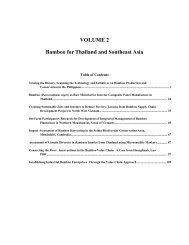WBC-VIII-Vol.4 – Resources – Forestry, Plantations and ... - BambuSC
WBC-VIII-Vol.4 – Resources – Forestry, Plantations and ... - BambuSC
WBC-VIII-Vol.4 – Resources – Forestry, Plantations and ... - BambuSC
Create successful ePaper yourself
Turn your PDF publications into a flip-book with our unique Google optimized e-Paper software.
aboveground <strong>and</strong> belowground competition results in decreasing annual rates of biomass gain. Control of<br />
st<strong>and</strong>ing-culm density is the most important measure to combat such a decline in productivity.<br />
In order to be sustainable, outputs from production must be at least matched by inputs, <strong>and</strong> provision of those<br />
inputs must not jeopardise the sustainability of the resource pool from which the inputs are drawn.<br />
Four major examples may be cited. Firstly, the pool of carbon dioxide which provides the chemical basis for<br />
much of biomass (on average c. 50% by dry weight of biomass is carbon <strong>–</strong> Scurlock et al. 2000) is to all intents<br />
<strong>and</strong> purposes limitless, <strong>and</strong> unlikely to diminish because of the photosynthetic dem<strong>and</strong> by bamboo. Within the<br />
canopy on still days carbon dioxide may drop to a concentration that does limit photosynthesis, but that is<br />
another story. Secondly, the fresh water resource available to bamboo globally is sufficient to satisfy the dem<strong>and</strong><br />
by 40 Mha of bamboo, but locally this may not be so. Spatial heterogeneity in the distribution of water<br />
resources for bamboo, whether it simply be rainfall or captured <strong>and</strong> stored water resources, will influence the<br />
biomass production of bamboo, <strong>and</strong> the choice of plantation set-ups. Inordinate dem<strong>and</strong> on stored water<br />
reserves to the detriment of that water use by other industries, especially if the total resources are depleted over<br />
time, cannot be considered as sustainable. Practices to increase the efficiency of producing shoots or culms per<br />
unit of water uptake <strong>and</strong> to optimise the use of the water resources should be implemented.<br />
Thirdly, the spatial heterogeneity of mineral nutrients contained with the soil likewise strongly influences<br />
bamboo biomass production, <strong>and</strong>, if not replenished as they are removed in harvested shoots <strong>and</strong> culms, can<br />
limit the sustainability of bamboo st<strong>and</strong>s. As a final example, the availability of labour or mechanical practices<br />
that satisfy the high dem<strong>and</strong>s for either by the bamboo crop will constrain the sustainability of bamboo<br />
production. Excessive costs for mechanical solutions to harvesting <strong>and</strong> processing of bamboo products, or<br />
competition with alternative livelihoods for the normally surplus labour pool, can limit the sustainability of<br />
bamboo production. These need to be considered when planning for expansion of the industry. On the positive<br />
side, establishment of new bamboo plantations <strong>and</strong> their intensive management open up new job opportunities<br />
<strong>and</strong> scope for economic growth, regionally <strong>and</strong> nationally.<br />
In order to address the sustainability of bamboo production, from an input-output perspective, it is necessary<br />
firstly to consider potential yield <strong>and</strong> output data, <strong>and</strong> then to relate that to known resource availabilities <strong>and</strong> to<br />
resource use efficiency by bamboo st<strong>and</strong>s in the face of varying input availabilities.<br />
Expected bamboo yields<br />
Bamboo is best known for its fast growth rate. It can produce harvestable culms within 4<strong>–</strong>7 years of planting,<br />
which subsequently can be harvested annually. For this reason, it is expected that in the future, the major<br />
dem<strong>and</strong> for bamboo will be for timber substitution more than for edible shoots. Recognising this potential, in<br />
recent years, there has been increasing documentation of bamboo productivity (Isagi 1994; Isagi et al. 1997;<br />
Kleinhenz <strong>and</strong> Midmore 2001; Hunter <strong>and</strong> Wu 2002; Wang 2004; Castaneda-Mendoza et al. 2005; Midmore<br />
2009a).<br />
Focusing on the above-ground culm biomass, but excluding data for branches <strong>and</strong> leaves (<strong>and</strong> data that appear<br />
erroneous), the above-ground culm weight of the highest-yielding bamboo st<strong>and</strong>s (c. 150 t/ha) is similar to that<br />
<strong>VIII</strong> World Bamboo Congress Proceedings Vol 4-70




